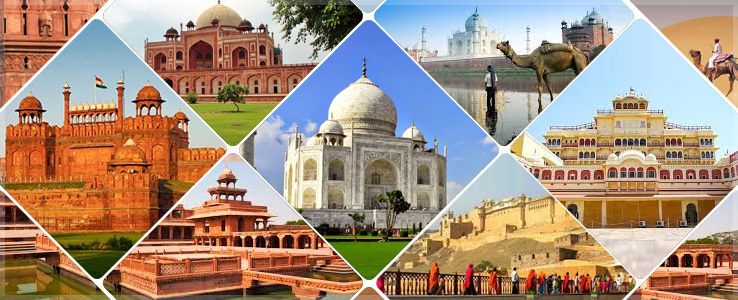India’s Golden Triangle, connecting Delhi, Agra, and Jaipur, is one of the country’s most iconic travel routes. It offers a deep dive into India's rich heritage, Mughal and Rajput architecture, bustling bazaars, and timeless traditions. Knowing the best time to explore this circuit not only enhances your travel experience but also ensures comfort, cultural immersion, and efficient planning.
This detailed guide provides an in-depth seasonal breakdown to help travelers decide when to embark on their golden triangle india tour package based on climate, crowd levels, festivals, and practical travel factors.
Winter (October to March) – The Most Preferred Season
Overview:
Winter is generally considered the most comfortable and popular time to travel the Golden Triangle route. The temperatures are mild, ranging from 8°C to 25°C, which makes sightseeing and outdoor exploration pleasant.
Benefits of Visiting in Winter:
-
Comfortable Weather: Ideal for walking tours, exploring forts, and visiting open-air markets.
-
Clear Skies for Photography: With low humidity and haze, winter offers excellent visibility for capturing iconic monuments like the Taj Mahal.
-
Festivals and Cultural Events: Travelers may witness Diwali, Holi (early March), and the Jaipur Literature Festival, adding depth to the cultural experience.
-
Wildlife Safaris: It is also the best time to enjoy a Ranthambore Gypsy/Jeep Safari when the chances of spotting tigers and other wildlife increase due to favorable forest conditions.
Cautions:
-
High Tourist Footfall: Being peak season, major attractions are crowded.
-
Advance Booking Required: Accommodations and transport may need to be booked well in advance to avoid last-minute price surges.
Summer (April to June) – Suitable for Specific Interests
Overview:
Summer in northern India can be intense, with temperatures soaring up to 45°C. While not traditionally recommended for leisure tourism, the season has unique advantages for specific types of travelers.
Advantages of Summer Travel:
-
Fewer Crowds: Attractions are significantly less crowded, offering a quieter, more personal experience.
-
Budget-Friendly: Travel and accommodation costs are lower due to reduced demand.
-
Sunrise and Sunset Views: Early morning visits to landmarks like the Taj Mahal or Amber Fort are serene and rewarding.
Challenges:
-
Heat and Humidity: The high temperatures may limit daytime exploration.
-
Hydration and Health Risks: Travelers must take precautions like carrying water, wearing breathable clothes, and avoiding extended sun exposure.
Recommendation:
If visiting in summer, early morning or evening explorations are advisable. A well-planned Same Day Guided Tajmahal Tour with Agra Fort and Baby Taj starting at sunrise can make the most of the cooler hours.
Monsoon (July to September) – For Offbeat Travelers
Overview:
The monsoon season brings relief from the summer heat, with intermittent rain and cooler temperatures. While some may find the weather unpredictable, monsoon adds a lush green charm to the Golden Triangle landscape.
Reasons to Consider Monsoon Travel:
-
Fresher Surroundings: Parks, palace gardens, and rural landscapes are more vibrant.
-
Photographic Appeal: Rain-washed forts, palaces, and reflective monuments offer unique visuals.
-
Authentic Local Life: Travelers can witness locals celebrating festivals like Teej and Raksha Bandhan.
Drawbacks:
-
Travel Disruptions: Occasional waterlogging and delays in train or road transport.
-
Humidity: Although temperatures are lower, the increased humidity may be uncomfortable.
Advice for Monsoon Trips:
Carry waterproof gear, flexible travel plans, and extra time for contingencies. Those seeking deeper cultural immersion might enjoy quieter museums, workshops, and local gatherings during this time.
Choosing the Right Time Based on Interests
The Golden Triangle is not just about visiting historical monuments—it offers wildlife safaris, local markets, traditional cuisine, and immersive cultural experiences. Timing your visit according to personal interests helps in crafting a more meaningful itinerary.
-
For Wildlife Enthusiasts: Visit during winter for an optimal Ranthambore Gypsy/Jeep Safari.
-
For History Buffs: Anytime is suitable, but winter and early summer mornings are perfect for exploring forts and palaces.
-
For Festival Lovers: Plan around Diwali (October/November), Holi (March), or local fairs.
-
For Budget Travelers: Summer and monsoon seasons offer better pricing and less crowding.
Combining Seasonal Insights with Other Rajasthan Routes
Many travelers extend their Golden Triangle journey into broader regional explorations such as Udaipur, Jodhpur, or Mandawa. Choosing from curated Rajasthan Tour Packages during suitable seasons allows travelers to witness royal heritage, desert landscapes, and architectural marvels beyond the main circuit.
Travelers interested in architecture and heritage often prefer the shoulder season (late September or early April) for a balanced experience across the Golden Triangle and Rajasthan's extended destinations.
Final Thought: Plan with Purpose, Not Just a Calendar
While October to March remains the most recommended time to explore the Golden Triangle, the best time ultimately depends on your purpose—be it photography, solitude, cultural events, or budget. India’s Golden Triangle is not just a fixed route but a living story that changes with the seasons.
When informed by seasonal awareness and guided itineraries like a Same Day Guided Tajmahal Tour with Agra Fort and Baby Taj or a full-fledged golden triangle india tour package, every traveler can craft a journey aligned with their pace and preferences.
Let your curiosity and planning go hand-in-hand—because the Golden Triangle always has more to reveal when visited at the right time.
